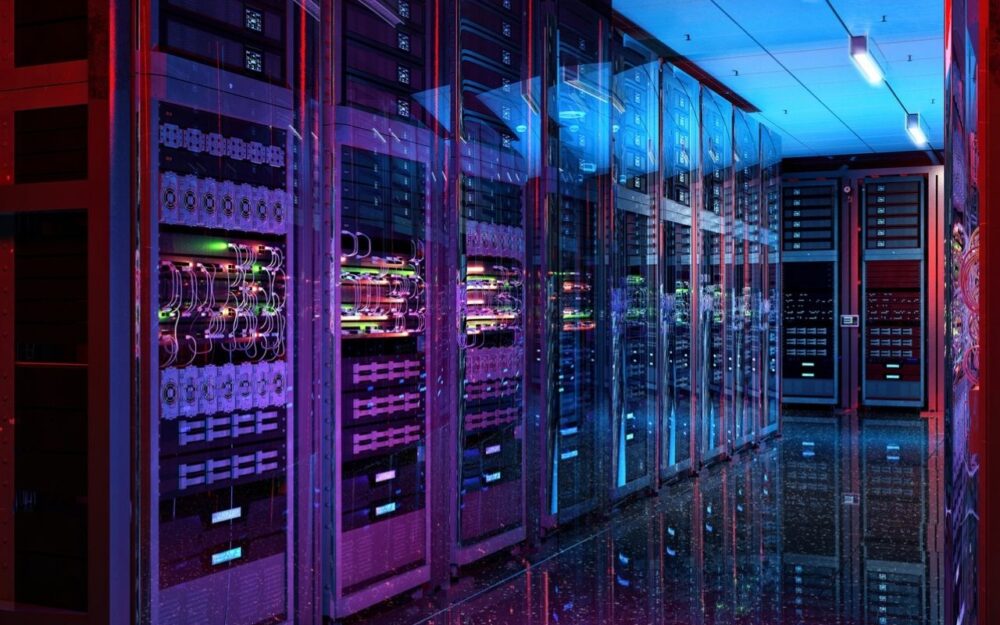At a press conference we attended this week, The Shift Project presented its latest report on the energy and climate impact of digital infrastructures, particularly data centers in the era of generative AI. The think tank warns of a surge in electricity consumption and CO₂ emissions, and proposes recommendations to reconcile AI deployment with sustainability.
This 2025 report (available here in French) aims to inform the public debate on the climate challenges linked to AI. Since its foundation in 2010, by French engineering consultant Jean-Marc Jancovici, the French association has consistently focused on promoting the transition to a post-carbon economy. For over eight years, it has specifically analyzed the interactions between digital technology and the energy transition.
“Today, the new structuring dynamics of digital technology are linked to the physical computing infrastructures for artificial intelligence,” says Maxime Efoui-Hess, coordinator of the Digital Program at the Shift Project.
Hence this new report.
A Strategic Sector Under Constraint
The report, presented earlier this week after 15 months of research, focuses on data centers, the true backbone of the digital economy. They host both traditional uses (web hosting, social networks, video platforms, cloud services) and newer applications such as cryptocurrencies and, most importantly, AI and generative AI. Physical infrastructure includes electrical hardware, GPUs, processors, and cooling systems. According to Shift Project researchers, the sector is on “an unsustainable climate trajectory.”
According to Marlène de Bank, digital research engineer at the Shift Project, the global carbon footprint of data centers could quadruple by 2030, rising from 250 MtCO₂e/year in 2020 to nearly 920 MtCO₂e/year.
“That’s equivalent to twice France’s annual emissions across all sectors,” she emphasizes.
By 2030, the data center sector could contribute two to three times more to climate disruption than in 2020.
“This effectively adds 50 MtCO₂e per year to human emissions.”
Electricity Consumption Out of Control
To understand these figures, one must first look at electricity consumption. Globally, data center energy use is skyrocketing:
“It was 400 TWh in 2020, and we are heading towards 1,250 to 1,500 TWh by 2030,” notes Marlène de Bank.
The International Energy Agency (IEA) projects similar numbers, estimating data center electricity demand could reach 945 TWh in 2030, up from 415 TWh in 2024. This growth, largely driven by the United States, is fueled primarily by generative AI and the explosion in computing power. Experts forecast that GPU numbers could rise from 9 million today to 60 million by 2030.
These findings are confirmed by GlobalData, which notes that
“data centers are expanding at a record pace to meet both AI workloads and sustainability requirements.”
According to GlobalData’s Strategic Intelligence – Data Centers report, most AI training takes place in large-scale facilities requiring specialized chips, massive memory, and advanced cooling systems.
Financial pressure is also intense: Microsoft, Alphabet, Amazon, and Meta invested $245 billion in 2024, with projections exceeding $360 billion in 2025, mostly to support AI. Martina Raveni, analyst at GlobalData, explains:
“They are competing to build large data centers and equip them with specialized chips to stay ahead in the AI race.”
But this race for AI comes with an environmental cost, as we previously reported in one of our articles.
Read our story on The Environmenal Costs of AI
The energy impact of AI depends on three factors: model size (number of parameters, versatility, precision), type of tasks (classification, content generation, video, images), and the structuring of computation steps.
“From training to usage, a generative AI model consumes increasing amounts of hardware and computing resources. The larger, more versatile, and more precise it is, and the more frequently it is used, the greater its consumption.,” explains Maxime Efoui-Hess.
AI companies are aware of these challenges and have implemented energy and carbon efficiency solutions. For example, the sector is exploring innovative cooling technologies, including liquid cooling, to limit environmental impact. Yet despite optimization efforts, the footprint has continued to grow over the past decade. According to Alexandre Theve, member of the Digital Expert Group at the Shift Project,
“Generative AI already represents 15% of global data center electricity consumption and could reach 35% in five years, then 45% by 2035.”
Fossil-Fuel Electricity
The problem is that currently, more than 50% of electricity consumed by data centers worldwide comes from fossil fuels. And future demand is expected to be similar. Contrary to many predictions, global data center electricity consumption is far from being curbed by efficiency improvements.
As Marlène de Bank of The Shift Project emphasizes, achieving a 90% reduction in the carbon footprint of data centers by 2050 (in order to respect the EU climate neutrality strategy for 2050) requires respecting strict limits on electricity use, even if all power were fully decarbonized.
“Annual consumption should not exceed 1,000 TWh, with a more ambitious target at 200 TWh. Beyond this threshold, it becomes impossible to ensure the sector’s decarbonization. Current trends already far exceed these limits,” she explains.
Such scenarios underscore that electricity consumption is intrinsically tied to the carbon footprint of embedded infrastructure—including servers, IT equipment, cooling systems, and buildings—as well as to the progress of the energy transition. Even in highly decarbonized configurations, there remains a hard ceiling on electricity use. Data center infrastructures are therefore becoming an additional environmental problem to manage.
Usage Conflicts: The Irish Case
Another issue is the risk of saturation. The Irish example illustrates the tensions caused by rapid data center growth. Hugues Ferreboeuf, digital project manager at the Shift Project, notes:
“The share of data centers in Ireland’s electricity consumption rose from 5% in 2015 to 20% in 2022. That’s meteoric growth, equal to the entire country’s industry.”
Ireland is an atypical case. Since 2015, the country has attracted numerous US data centers due to very favorable tax policies. But the expansion was unplanned, leading to consequences for the electrical grid. Around Dublin, the national electricity operator could no longer supply all users. Some real estate projects were blocked due to grid limitations. Since 2022, a moratorium prevents the connection of new data centers in Dublin until the grid is relieved.
“But this hasn’t slowed the installation of data centers, which have found workarounds,” explains Hugues Ferreboeuf. “Fifteen data centers are connected to dedicated power plants linked to the gas grid. Data centers have effectively become their own electricity operators. The same occurs in some US counties for similar reasons. This is not a minor issue.”
Europe and France Facing Saturation Risks
What’s the situation in the rest of Europe? Amsterdam also has a moratorium. But other European governments still seek to attract US data centers.
France, for example, is now attracting such infrastructures. In Marseille (DirectIndustry has reported from Marseille’s data centers on several occasions) and the Paris region, projects are multiplying, encouraged by government announcements. Last February, at the AI Summit, French electricity operator EDF offered four sites on its land. The French government announced 35 ready-to-use sites, and the president pledged €109 billion for investments including data center infrastructure. Also, new regulations are facilitating infrastructure deployment like the fast-track procedures for grid connection.
Currently, data centers represent around 2% of France’s total electricity consumption (~2 TWh), equivalent to the annual electricity of 2.5 million households or half of France’s annual solar electricity production. The Shift Project predicts this share could reach 7.5% by 2035.
At the European level, data centers account for 2.5% of total electricity consumption, growing 7% per year. This share could double by 2030 and triple by 2035. As in Ireland, Hugues Ferreboeuf warns of potential conflicts of use:
“We will face a situation where we have to supply these data centers at all costs. Facing this electricity shortage, the simplest solution, as in Ireland and the US, will be to build gas power plants or keep existing ones running. Continuing this gas consumption also prolongs the EU’s energy dependence via LNG imports. Trump is encouraging us to buy more, and that’s no coincidence.”
France, thanks to nuclear power, has a slightly different situation. In 2024, the country had a 90 TWh electricity surplus, but the Shift Project notes this surplus may not cover all upcoming data centers. Pauline Denis, digital research engineer at the organization, says:
“The data center sector is not yet integrated into the SNBC3 (National Low-Carbon Strategy), so we cannot plan the decarbonization of this sector.”
Risks to the Energy Transition and Reindustrialization
Relying on gas-fired power for data centers in Europe negatively affects the continent’s decarbonization trajectory, emission reduction efforts, and may jeopardize Europe’s ability to meet climate targets. Hugues Ferreboeuf explains:
“By 2035, Europe plans to cut 200 TWh of gas-generated electricity (100 MtCO₂e). But 200 TWh is precisely the additional electricity these data centers will consume. If nothing is done, these 200 TWh will not disappear, and Europe’s decarbonization roadmap will be undermined.”
This also endangers the energy transition for sectors that require full electrification, such as transport and heating. Cooling systems and water consumption add further pressure, particularly in water-stressed regions like Marseille.
Data centers therefore pose risks to Europe’s energy transition and also to its reindustrialization efforts. Hugues Ferreboeuf adds:
“If European companies struggle to consider returning operations to Europe, it’s also due to a lack of confidence in the availability of decarbonized electricity. By signing data center projects in Europe, you commit to providing electricity. And if there isn’t enough, difficult choices will have to be made. Will the data center take priority over, say, the Dunkirk steel plant?”
Towards “Sustainable AI”?
For the Shift Project, these risks highlight the urgency of deploying AI within strict ecological limits. AI is an ambivalent catalyst, neither entirely good (AI for Green) nor bad (AI for Brown).
“AI improves efficiency, productivity, and speed. But deploying it broadly builds an AI that is just as fossil-fuel-dependent as the economy it operates in, increasing emissions. Any AI deployment must be compatible with a carbon trajectory,” emphasizes Maxime Efoui-Hess.
This requires evaluating use cases, favoring leaner AI models, and sometimes opting not to use AI:
“If a solution cannot be deployed in compatibility with carbon constraints, it should be abandoned or replaced by non-AI or lower-impact solutions. Like an economic budget, if the carbon allowance isn’t there, you don’t deploy and find other, less intensive solutions. AI should be deployed selectively, based on priority needs.”
Sometimes, avoiding AI may be simpler and less costly. The French Association for Standardization, AFNOR, for example, has introduced a frugal AI framework promoting small models and optimized equipment to reduce environmental impact.
The Shift Project identifies two key levers: first, AI suppliers can design lightweight models with selected features to reduce energy consumption; second, organizations and users can deploy AI selectively on priority use cases compatible with climate trajectories, supported by impact analysis.
However, researchers stress the need for strict European-level planning and binding regulations, which currently do not exist, setting reference carbon-energy trajectories and sectoral emission/consumption ceilings.
The report also calls for mandatory transparency on AI energy use. Some Big Tech companies like Meta are already taking steps, but efforts remain to be made. According to both the Shift Project and GlobalData, without systemic regulation, the AI boom risks worsening the very climate challenges it aims to address.
Read also | China’s Clean Energy Strategy







![Image [Buying Guide] How to Choose the Right Safety Shoes?](/wp-content/uploads/sites/3/Safety-Shoes-320x213.jpg)


![Image [Buying Guide] How to Choose the Right AMR?](/wp-content/uploads/sites/3/AMR-320x213.jpg)
